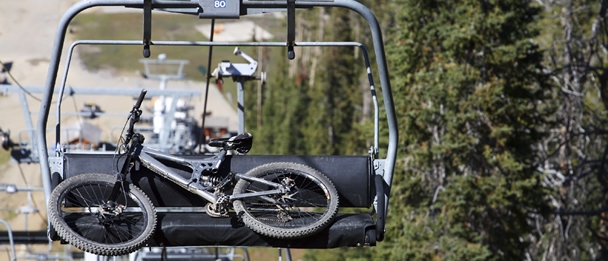The Rise of Bike Parks
14 Sep 2011

by Chris Moran, co-author of Mountain Biking Europe
 Bike Park riders owe a debt of gratitude to the skateboarding children of the 1970s. "Two hundred years of American technology unwittingly created a massive cement playground of unlimited potential,” wrote skateboarding historian Craig Stecyk, “but it was the minds of 11 year olds that could see that potential." And when entrepreneurs of the same decade turned that potential into the first concrete ‘skateparks’, they were literally cementing the notion that fun could be contained within a condensed, exciting area - a place where gravity could be challenged and defeated. When snowboarding elbowed its way into ski resorts around the world, Vail in Colorado was the first to assimilate this idea, opening the world’s first snow ‘fun park’ in 1991; and later that same decade, with mountain biking’s popularity exploding, a certain pioneering Canadian resort opened the functionally-named Whistler Mountain Bike Park in 1998 to huge success. Today, an estimated 100,000 visitors roll through its gates.
Bike Park riders owe a debt of gratitude to the skateboarding children of the 1970s. "Two hundred years of American technology unwittingly created a massive cement playground of unlimited potential,” wrote skateboarding historian Craig Stecyk, “but it was the minds of 11 year olds that could see that potential." And when entrepreneurs of the same decade turned that potential into the first concrete ‘skateparks’, they were literally cementing the notion that fun could be contained within a condensed, exciting area - a place where gravity could be challenged and defeated. When snowboarding elbowed its way into ski resorts around the world, Vail in Colorado was the first to assimilate this idea, opening the world’s first snow ‘fun park’ in 1991; and later that same decade, with mountain biking’s popularity exploding, a certain pioneering Canadian resort opened the functionally-named Whistler Mountain Bike Park in 1998 to huge success. Today, an estimated 100,000 visitors roll through its gates.
The idea of the Bike Park then, whilst less than 15-years old, has roots going back as far as the 1970s. And once it was shown to work in the cycling world, anyone with a lift and a hill could replicate the idea. Les Gets and Morzine - in the heart of the huge Portes du Soleil ski area - were quick to react, and are now the recognised European hub of mountain biking; but strangely, while many other European ski areas were also well-placed to cash in on the potential summer revenue that mountain biking offers, those with a more traditional client base were slow to react. Chamonix, St Anton, Verbier and other flagship resorts have only recently converted to the Bike Park movement. So why the delay?
The answer is that often smaller, low-altitude resorts can offer more, for less. Suddenly, ski areas almost bankrupted by climate change were thrown a summer lifeline. Here was warm-weather sport which used their existing infrastructure and had the potential to bring in more money than their skiing business model. Schladming and Leogang in Austria - ski areas to be found in few international brochures - became giants in the rapidly-expanding mountain bike world because of their early commitment to the sport. Some resorts were even brought out of virtual comas: Germany’s Bad Wildbad’s antiquated funicular railway - a throwback to skiing in the first half of the 20th Century - was long past the sell-by date. By the mid 2000s, its wooden seats were crammed with mountain bikers every summer weekend.
“A person who never made a mistake," said Albert Einstein, "never tried anything new,” and in the mountain bike world, those willing to experiment have had the potential to reap huge rewards. Energized by a fresh, youthful movement, 'shapers' (often ex pro mountain bikers), have created exciting bike parks in the most unlikely of places. Riders still flock to mountain resorts in large numbers, but parks have sprung up in English forests, on the outskirts of European cities, on Mediterranean islands, and in countryside warehouses and derelict city land.
The key to beckoning riders from afar is to have the latest twists in the bike park world, and its this ever-perpetuating competition that means today we can ride gravity assisted parks or flatland pump tracks, tackle drops graded from beginner through to death-defying, challenge ourselves on wallrides, northshore obstacles and on 4X tracks, or test our air-time skills on dirt jumps and practice airbags. Or we can just potter around on mounds of dirt and create lines just for the hell of it, just like those skaters of American city streets did over 35 years ago.
In short: there’s never been a better time to be a mountain biker.

Comments